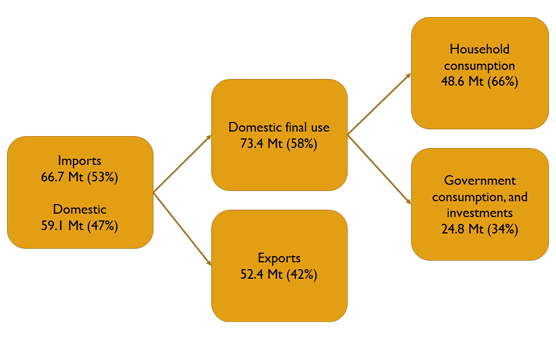The consumption-based greenhouse gas emissions have not decreased between years 2005 and 2015 although the territorial emissions decreased substantially The majority of consumption-based emissions are generated by household consumption. Investments and public procurement also account for significant shares of total emissions.

Greenhouse gas emissions of the Finnish economy (125.8 Mt CO2e in total) divided by purposes in 2015. Domestic final use can be also seen as carbon footprint of Finland. The footprint was 33% bigger than the territorial emissions (55.2 Mt CO2e) which form the basis of the official national emission inventories. © SYKE
The greenhouse gas emissions generated by household consumption are many times higher than those of public consumption and investments. In 2015, household consumption generated 66% of Finland’s consumption-based emissions, whereas the shares of public consumption and investments were 12% and 19% respectively.
In 2015, Finland’s total consumption-based emissions were 33% higher than Finland’s regionally generated, i.e. official, greenhouse gas emissions. The difference is due to the fact that consumption-based emissions also take into account imports and exports.
The increase in household consumption negates the benefits of technological advancement
In 2016, the carbon footprint of Finnish households was 60 million tonnes of carbon dioxide, which was 12% higher than in 2000, largely due to an increase in consumption expenditure. Income has a major impact on the emissions generated by household consumption, whereas the impact of place of residence and family type are lower, according to a study conducted by the Finnish Environment Institute (SYKE).

Average per capita consumption expenditure and carbon footprint of Finns in 2000–2016. © SYKE
“Although we are starting to see decoupling between emissions and economic growth in regard to consumption, the overall situation is worrying. The development of low-carbon technologies and the shift in consumption towards consumer goods with lower emissions have somewhat mitigated carbon footprint growth. However, it seems that these technological and structural changes have not been rapid enough to counteract the impact of growing consumption expenditure”, says Researcher Hannu Savolainen from the Finnish Environment Institute.
In 2016, transportation accounted for 30%, housing and related energy consumption accounted for 29%, food and non-alcoholic beverages accounted for 19%, and other goods and services accounted for 22% of the carbon footprint of household consumption in Finland. However, the share of housing has decreased and the share of other goods and services has increased from the 2000 level.
Carbon footprint of public procurement calculated for the first time
The carbon footprint of Finnish public procurement was 8.3 million tonnes carbon dioxide equivalent in 2015. Government procurement accounted for 21%, municipal procurement accounted for 57% and joint municipal authority procurement accounted for 22% of the total carbon footprint of public procurement.
The administrative branch with the highest greenhouse gas emissions was the administrative branch of the Ministry of Defence, followed by those of the Ministry of Transport and Communications and Ministry of the Interior.
The types of procurement expenditure with the highest emissions were heating and electricity, construction and maintenance services for buildings and areas, and travel and transport services. Food, cleaning and laundry services, fuels and lubricants, and drugs and treatment supplies also generated a significant proportion of emissions.
“Reducing consumption-based emissions requires converting domestic energy production and other manufacturing processes into low-carbon processes. In addition to this, we need ways of steering households, municipalities, joint municipal authorities and government organisations towards choosing goods and services with a smaller carbon footprint”, says Development Manager Ari Nissinen from the Finnish Environment Institute.

Volume of public procurement, greenhouse gas emissions, and raw material requirement in 2015. © SYKE
Finnish households’ consumption of raw materials at an unsustainable level
In Finland, the consumption of raw materials is notably high both in relation to gross domestic product and per capita. In 2015, public procurement consumed 19.5 megatonnes of raw materials, whereas households consumed 64.8 megatonnes.
The areas in which the consumption of raw materials was highest in regard to satisfying household consumption were construction, energy production and food production. By contrast, in public procurement the emphasis was on the large material flows of earth construction. Approximately half of the material flows of Finland’s economy originate from abroad.
The study by the Finnish Environment Institute analysed the life-cycle greenhouse gas emissions and raw material consumption of public procurement and household consumption in Finland. The method used in the analysis was the environmentally extended input–output model ENVIMAT, which was supplemented with statistics on public procurement.
Report: Carbon footprint and raw material requirement of public procurement and household consumption in Finland - Results from the ENVIMAT-model (Reports of the Finnish Environment Institute 15/2019)
The report and press release have been published in Finnish on 8th April 2019.
Further information
- Development Manager Ari Nissinen, Finnish Environment Institute (SYKE), tel. +358 (0)295 251 457, firstname.lastname@ymparisto.fi
- Researcher Hannu Savolainen, Finnish Environment Institute (SYKE), tel. +358 (0)295 251 839, firstname.lastname@ymparisto.fi